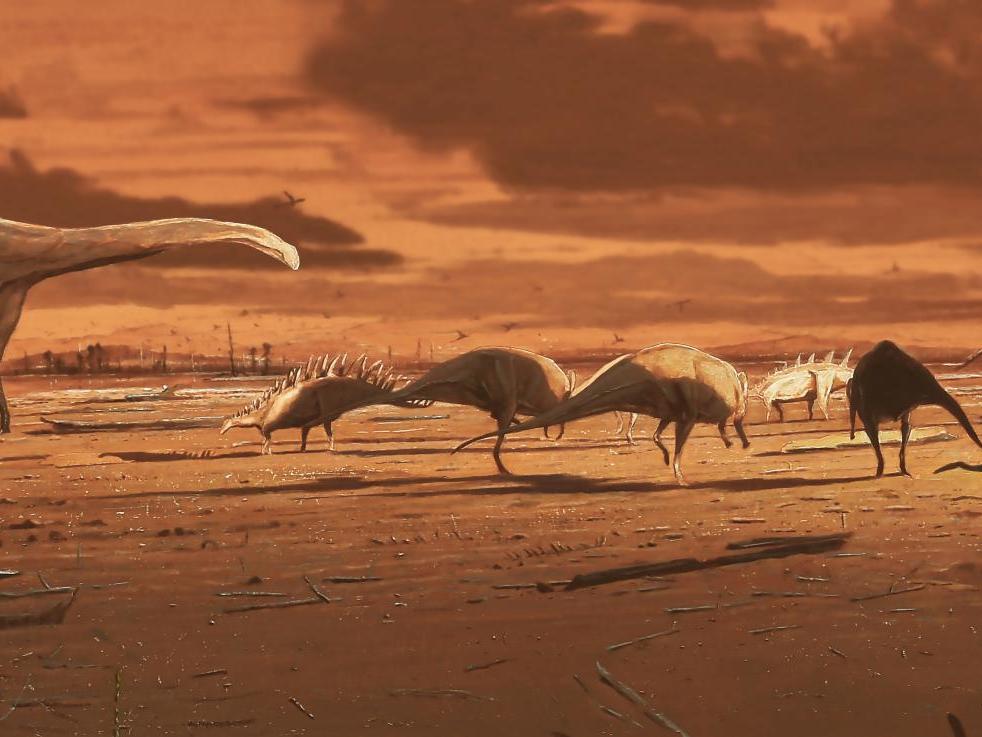Stegosaurus footprints found on Skye first evidence iconic dinosaur roamed Scotland
Significant find sheds new light on evolution of creatures during mid-Jurassic period, 170 million years ago

Your support helps us to tell the story
From reproductive rights to climate change to Big Tech, The Independent is on the ground when the story is developing. Whether it's investigating the financials of Elon Musk's pro-Trump PAC or producing our latest documentary, 'The A Word', which shines a light on the American women fighting for reproductive rights, we know how important it is to parse out the facts from the messaging.
At such a critical moment in US history, we need reporters on the ground. Your donation allows us to keep sending journalists to speak to both sides of the story.
The Independent is trusted by Americans across the entire political spectrum. And unlike many other quality news outlets, we choose not to lock Americans out of our reporting and analysis with paywalls. We believe quality journalism should be available to everyone, paid for by those who can afford it.
Your support makes all the difference.Scientists have discovered footprints left by stegosaurus dinosaurs 170 million years ago on the Isle of Skye, the first evidence the iconic creatures once lived in Scotland.
A team of palaeontologists from the University of Edinburgh found the line of grapefruit-sized prints after a storm in 2017 pushed aside boulders that had hidden them for years.
The triangular footprints were left by a stegosaurus about the size of a cow as it walked along a mudflat next to what was then a shallow lagoon, 170 million years ago.
Today, the site is known as Brothers Point on the north eastern coast of Skye, which has acquired the nickname Dinosaur Isle thanks to the number of fossils found.
Researchers identified a line of prints in a right-left pattern and in two different sizes, which indicate the gait of a four legged animal with smaller front feet.
“These footprints are the first evidence we have that this very major, very iconic group of dinosaurs lived in Scotland,” Dr Stephen Brusatte, one of the palaeontologists who led the research, told The Guardian.
Writing in the journal Plos One, the team explain they also found about 50 other dinosaur prints at the same location, revealing the coastal mudflats were home to a thriving community of animals.
Stegosaurs are among the most well-known dinosaurs, famous for their iconic diamond-shaped plates, which protrude along their backs, and a dangerous-looking spiked tail.
Although the largest stegosaurus species could grow up to nine metres long and weigh 30 tonnes, the particular dinosaur that left its footprints behind at Brothers’ Point was much smaller and could have been a youngster.
Dr Brusatte said the findings shed light on what life would have been like on the Isle of Skye during the mid-Jurassic period, about 170 million years ago.
““It would have been overrun with … so many different types of dinosaurs: meat-eaters, plant eaters, big ones, small ones, ones that were running around, ones that were wading in the water, ones that had long necks, ones that had plates on their backs.
“It was an island in the middle of the ever-widening Atlantic with this subtropical, wet, humid, hot climate with rivers draining mountains in the middle of the island, emptying out into the ocean; and then beaches and lagoons fringing the coasts — and these places were havens for dinosaurs and for all kinds of other species.”
Because fossils from this era are relatively rare worldwide, the Skye finds are very important evidence for palaeontologists trying to better understand dinosaur evolution.
The Scottish government last year issued a Nature Conservation Order for Skye to legally protect the important sites, some of which have already been damaged by private collectors.
Although scientists have been working on Skye for decades since the first dinosaur fossils were found, these footprints were only discovered thanks to a freak storm in 2017 that pushed aside boulders that had been covering them.
The University of Edinburgh team said this emphasised the importance of re-examining even well-studied locations.
Subscribe to Independent Premium to bookmark this article
Want to bookmark your favourite articles and stories to read or reference later? Start your Independent Premium subscription today.
Join our commenting forum
Join thought-provoking conversations, follow other Independent readers and see their replies
Comments